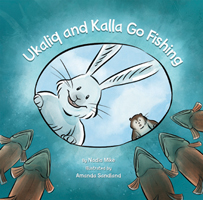| ________________
CM . . .
. Volume XXIII Number 36. . . .May 26, 2017

 |
Ukaliq and Kalla Go Fishing.
Nadia Mike. Illustrated by Amanda Sandland.
Iqaluit, NU: Inhabit Media, 2017.
32 pp., hardcover, $16.95.
ISBN 978-1-77227-135-5
Grades 2-4 / Ages 7-9.
Review by Dawn Opheim.
**½ /4
|
| |
|

excerpt:
Before Kalla was even ready, Ukaliq rushed back to his den to get his snowmobile. Without packing any snacks for the day, or ensuring he had enough gasoline for the trip, he set out for their favourite lake.
Meanwhile, Kalla carefully packed for the trip. He checked his snowmobile to see if he had enough gas and packed his qamutiik with an extra jerry can just in case.
Ukaliq and Kalla Go Fishing is a classic story of two friends who are complete opposites. Ukaliq, the Arctic hare, is impatient, demanding, loud, and scatterbrained. He does, at times, also come across as inconsiderate. Kalla, the lemming and careful planner in the story, is tolerant of Ukaliq’s behaviour and generous with his words and actions towards his friend. The story begins with Ukaliq thumping his foot on the top of Kalla’s burrow (resulting in spilling Kalla’s morning tea and knocking dirt on his head) while demanding Kalla hurry up so they can go ice fishing. Without waiting for a response, Ukaliq rushes home to grab his fishing rod and a snowmobile (but no other supplies) and heads out to their favourite lake (also without telling Kalla where he’s going!) Kalla, on the other hand, double checks the gas in his snowmobile, brings extra gas, and gathers a snack before meeting Ukaliq at the fishing spot. In predictable fashion, the story continues with Ukaliq not being able to catch any fish due to his impatience, getting hungry because he forgot a snack, and being unable to get home because he ran out of gas. Kalla solves all of these problems with patient advice and his careful planning.
What makes this story unique is the setting and the dynamic between the characters. The story takes place in the Arctic, a setting which provides surroundings, animals, and terminology that children may not be familiar with (for example, the animals ‘snow bunting’ and ‘char’, and words like ‘qamutiik’ and ‘jerry can’). Fortunately, the majority of new words can be figured out in context and through examination of the pictures. What is more difficult to figure out is the relationship between the two characters. While Ukaliq and Kalla ‘seem’ to be friends (with much evidence to support this – Ukaliq knows where Kalla lives, they have a favourite fishing spot, Kalla has pictures of the two of them together in his burrow, etc), Kalla seems genuinely annoyed and unhappy with Ukaliq the entire story. He rolls his eyes, frowns, and sighs at all of Ukaliq’s actions, and Ukaliq appears jealous of Kalla and does not thank him or seem appreciative of his help. The two friends don’t look like they are having fun together.
Children reading this story may or may not notice the underlying tension between the characters. They will, however, enjoy the clean comic-style art from Amanda Sandland and the occasional humorous moments (like when Ukaliq almost gets pulled into the ice fishing hole by a large char!) Parents and teachers will be able to pull more out of this story and prompt children into conversations about what it means to be a good friend, new vocabulary (like ‘ensuring’, ‘jigging’, and ‘flared’) and different kinds of animals and habitats. A word of caution on this front, though, is that parents and teachers will need to know that Ukaliq is an Arctic hare and Kalla is a lemming as this information is not shared anywhere in the story or on the back cover (this information was provided in the accompanying story printout for the review). Ukaliq and Kalla Go Fishing would also be great as an introduction or complement to a study of the Arctic, as well as a good resource for predicting (what might happen if Ukaliq doesn’t pack snacks or extra gas?) and inferencing (how is Kalla feeling when he ‘sighs’ or ‘rolls his eyes’?) Because of the advanced vocabulary in the book, it will not be as accessible to children younger than seven but will still be enjoyable with an adult.
Recommended with Reservations.
Dawn Opheim, an avid reader with a Masters Degree in Teacher-Librarianship, works at two elementary school libraries in Saskatoon, SK.

To comment
on this title or this review, send mail to cm@umanitoba.ca.
Copyright © the Manitoba Library Association. Reproduction for personal
use is permitted only if this copyright notice is maintained. Any
other reproduction is prohibited without permission.
Next Review | Table of Contents For This Issue - May 26, 2017
CM Home | Back Issues
| Search
| CM Archive
| Profiles Archive
|
